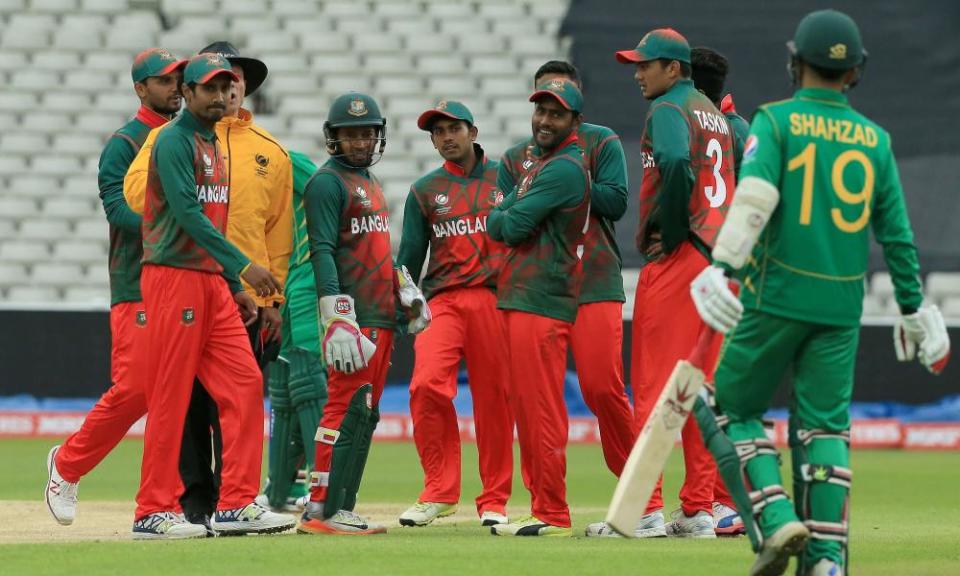Everything up for grabs for England in the quickfire Champions Trophy | Vic Marks

All eight teams competing in the Champions Trophy are here now; all can harbour thoughts of winning it. It takes five wins in a row to be guaranteed the delight of raising the cup to the skies in south London on 18 June. This is a far more palatable format for the players than the World Cup because no time is wasted. It is far more palatable for the fans as well. If the sun continues to shine the tournament will be a success.
From 1 June to 12 June there will be a match every day at one of three venues – The Oval, Edgbaston and Cardiff – followed swiftly by semi-finals and the final at the Oval. The likeliest teams to contest those semi-finals are Australia and England from Group A and India and South Africa from Group B. But take nothing for granted. There are no easy games .
The tournament kicks off with England playing against Bangladesh at the Oval. No problem there, then. Except that the last time these two teams met in an ICC competition, in Adelaide two years ago, Bangladesh deservedly won by 15 runs and therefore proceeded to the quarter-finals of the World Cup, unlike England.
Long gone are the days when Bangladesh felt overawed by any opponents. We can reel off their key batsmen without thinking. Tamim Iqbal, Mushfiqur Rahman, Shakib al Hasan and Mahmudullah are still going strong. Moreover, the pitches are dry and tend to be brown at the Oval and that is how Bangladesh – who beat New Zealand on Wednesday and lost to Pakistan on Saturday – like them.
The following day Australia meet New Zealand at Edgbaston, so Australia are bound to win that one. Except that New Zealand often reserve their best for when they are playing their noisy neighbours from across the Tasman. And there are the talents of Kane Williamson, Martin Guptill, Trent Boult and Tim Southee to consider.
Even without Brendon McCullum at the helm the Kiwis can beat anyone provided they are not too distracted by the remarkable explanation of their old team-mate, Doug Bracewell, when faced with a drink-driving offence back home. His lawyer used the Python defence. This revolved around a dead parrot, or cockatoo, which belonged to his increasingly distraught girlfriend. Bracewell raced home to offer consolation despite having taken a drink or two. In the end he pleaded guilty and took his punishment.
The Australians may be distracted by something more serious: the dispute between Cricket Australia and the Australian Cricketers’ Association over their contracts. David Warner, potentially one of the most devastating openers in the competition, has been more vociferous than most on this topic, even suggesting that players would forego playing in the Ashes this winter if necessary. Perhaps we may view Warner as Australia’s 21st-century Arthur Scargill. In which case he must be wary of the Scargill Shot, which has been played by many golfers as well as the odd opening batsman who does not quite evade the boundary fielder – “a good strike but where did it get you?”
Even more pertinently, Australia are the side with pace. It is a rare occurrence to find Mitchell Starc, Pat Cummins and James Pattinson fit simultaneously and the ever-reliable Josh Hazlewood is no slouch. Whether pace will be a great asset on three surfaces that are now usually brown, slow and true remains to be seen.
The old theory was that England prospered in ODI cricket when playing on juicy seamer-friendly pitches, which produce relatively low-scoring games. The template has changed now. With so many free-flowing players they prefer tracks where the batsmen can swing through the line with impunity.
Such benign surfaces encourage the presence of wrist-spinners, who can do something surprising. Australia have an interesting one, Adam Zampa, though perhaps the best in the world at the moment will not be playing, since Rashid Khan represents Afghanistan.
In Group B, there will be a selection of wrist-spinners as well. Oddly, India do not have one but they can rely on the tried and trusted Ravi’s, Ashwin and Jadeja. South Africa lean on the ubiquitous Imran Tahir, now 38. Twenty years younger than him is Pakistan’s Shadab Khan, who has played three ODIs. Sri Lanka have two back-of-the-hand men, Seekkuge Prasanna and the left-armer Lakshan Sandakan.
In that group Pakistan, now under the leadership of their wicketkeeper, Sarfraz Ahmed, are not expected to prevail. So they are bound to be dangerous. It was hard to banish a smile when learning that Umar Akmal has been jettisoned from the squad by the chairman of selectors because he has not paid sufficient attention to his fitness. That chairman is Inzamam-ul-Haq, who, when captain of Pakistan, spent much of his time in a wicker chair on the outfield when he was not batting in the nets on practice days.
Meanwhile, Sri Lanka must find it a wee bit frustrating to see that Kumar Sangakkara, now retired from international cricket, has scored yet another century for Surrey. If available he might just still squeak into their side, even though he tends to stick to the old-fashioned ploy of hitting the ball between the fielders rather than over their heads.

 Yahoo Sport
Yahoo Sport 





































